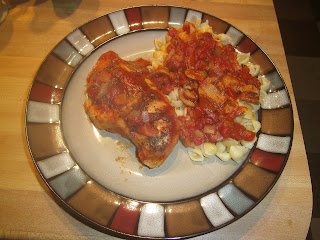Now, before we delve into this too deeply, I feel the need to bring up a point of etiquette; a notion I like to call "pie with a fork". In some parts of the world, it is acceptable to just scoop up a piece of pie and eat it by hand (assuming it is of the well-crusted variety). In other parts, it is not, and eating in such a vulgar manner could be considered insulting, or at least disgusting. Ergo, wherever you go, be prepared to eat your pie with a fork. Why is this relevant? Allow me to explain. . .
It should be noted that just because something is thoroughly cooked, doesn't mean the alcohol has been completely evaporated! Alcohol evaporates at 172°F, which means that, with sufficient cook time, sauces or gravies should come out fine. Baked or roasted foods, however, can still have between 5-25% of the alcohol remaining, depending on variables such as cooking time and exposed surface area. If you find yourself cooking for small children, pregnant mothers, recovering alcoholics, people with specific medical conditions (such as diabetes), or people who do not believe in using alcohol for anything other than its medicinal purposes, there are several non-alcoholic wines or beverage substitutes to chose from. Be considerate!
One of my most consistently-used recipes is a simple sauteed vegetable combination to accompany the meat and potato dishes that our house usually sees. I rough cut a good-sized onion with a couple of bell peppers (any color) and toss in some sliced mushrooms. I start them cooking with a small amount of oil, but when the onions just begin to get soft, I'll pour in about four or six ounces of beer and sprinkle the entire mess with some seasoned pepper. Reduce the heat and simmer the beer away, taking care to not let the veg scorch.
Red wines will give onions and mushrooms a deep flavor accent, making them the perfect addition to any gravy. Basically, saute the mushrooms and onions as above, then use them in any gravy mix you like. An easy variation is to add a cup of broth and whisk in about a quarter cup of flour. Simmer the mix down to the thickness you want (if you go too far, adding a little water will help. Season with salt, pepper, and parsley.
We've all worked with less expensive, leaner cuts of beef. Let's face it, not every meal can be filet of beef or prime rib--sometimes you just end up with a hunk of flank steak. The simplest way to make a piece of meat that has a lot of personality more manageable is with beer. The slightly acidic nature of the brew makes it an excellent tenderizer. Place the meat in a zip-sealed bag and add beer, marinating for anywhere between 4 and 12 hours.
A bit more complex and flavorful marinade that can be made into an accompanying gravy or used as a fond for roast beef is found on page 9 of Cooking for Adventurers:
Mix--
1/3 cup red wine
1/4 cup beef broth
2 Tbsp. Balsamic Vinegar
1/4 Tsp. coarse, black pepper
3 minced garlic cloves
1 Tbsp. brown sugar
Marinate beef (steak or roast) in a gallon-sized zippered bag for 20 minutes to an hour (or longer, for tougher cuts of meat). To use as an accompanying sauce or fond for gravy, bring the reserved marinade up to a simmer and reduce to your desired consistency.
Cooking rarely has to be expensive or difficult (unless you actually want it to be). I seldom use expensive wines and, though I do like the more interesting brews, beers can be found cheaply, too. One thing I usually don't skimp on are spirits--even if you're only going to use them for sauces and marinades, cheap whiskies and bourbons can ruin recipes (you are going for flavor, after all). As far as which wines to use with what, that can truly be up to you. One of my favorite action movies involved a scene where the master spy figured out who the Russian agent was because he actually ordered red wine with fish! Horrors! True, reds are usually paired with red meats, as the tannins in the wine act as a palate cleanser for some of the bolder proteins and white wines are paired with white meats, as they tend to be a bit more acidic and compliment the proteins well (like a squirt of lemon on baked fish). In the end, though, go with what you like--just remember, those for whom you cook may have different tastes or convictions. Pie with a fork!

































